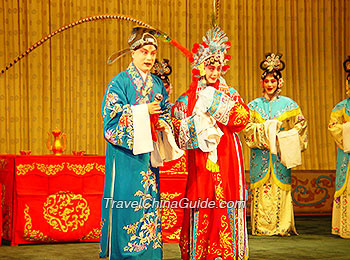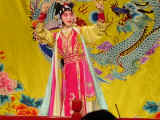
__What is it?__
The Chinese Opera is a combination of song, dance, acting, and literature all put together with colorful costumes, make-up, acrobats, and martial arts that comes into one performance on stage.
__How did it begin?__
The Chinese Opera is one of the three oldest dramatic art forms in the entire world. It began during the Tang Dynasty when Emperor Taizong had established a school for opera called Liyan or "Pear Garden". Since then, everyone from court officials to emperors have encouraged Chinese opera and has become a popular art form among many people today.
__Costumes/ Make-up__

One of the best known highlights in the Chinese Opera is the face painting. On every performer's face, exaggerated designs are painted on to show a character's personality, role, and fate. As some might not know, different colors symbolize different atitudes.
- __Red__: Devotion, courage, bravery, and loyalty.
- __Yellow__: Fierceness and ambition.
- __Green__: Violent or stubborn.
- __Blue__: For intelligence and the abiity to have loyalty through difficult times.
- __Purple__: Sophistication and uprightness.
- __White__: Treachery and suspicion
- __Black__: Roughness and fierceness.
Similar to the face painting, the color in the costumes also play an important role in symbolism as well as what rank and status they portray. For the men's costumes, they will wear long robes that are tied at the waist or just left straight down.


The women's costumes on the other hand is made up of a shirt that is either buttoned down in the front or the back as well as wearing a long flowing skirt.


__The Stage__
The props that are used in the opera are very simple and few in number. For example, a table and chair can be used multiple times within a scene to represent many different items. The Chinese opera is meant to be based on the person's imagination.

 Y!M:
Y!M:  www.sunnytang.com/images/performance/Chinese%2520Opera2.jp (profile)g" class="wikiimage" />
www.sunnytang.com/images/performance/Chinese%2520Opera2.jp (profile)g" class="wikiimage" /> 
__The Chinese Orchestra__

The music in a Chinese Opera is what makes the performances come alive. Their are 3 groups, such as the Wind Instruments, the String Instruments, and the Percussion that include a variety of different instruments, which are played in the opera.
Percussion
Of all the Chinese instruments, percussion is the most important. Giving off a deep and powerful rhythm, this is the one instrument that expresses a rich and emotional sound.
Percussion instruments that are used are:
- Different sized drums and gongs, cymbals and hand clappers.
String Instruments
String instruments can be categorized into 2 groups.
- Bowed Stringed
- These include fiddles that make a clear and elegant sound.
2. Plucked Stringed
- This category comes in a variety of shapes, structures, and functions. They include a banjo, a Chinese lute and a Moon guitar
Wind Instruments
- They include flutes, a chinese oboe, and a reed organ.
__Preparation__
While people just look at the opera as beautiful and artistic, they do not know that it takes years of required preparation and training for the performances of the Chinese Opera to take place. Starting in early youth, children will go through a series of classes that will specifically focus on one skill at a time needed for the opera. These include acting, speaking, singing, handling weapons, phisyical training, and gymnastics.


Comments (0)
You don't have permission to comment on this page.